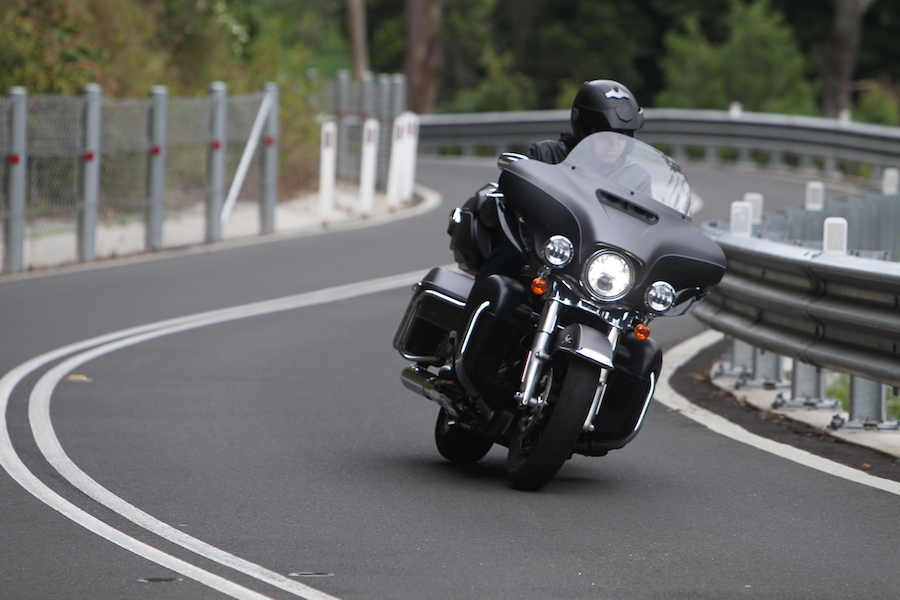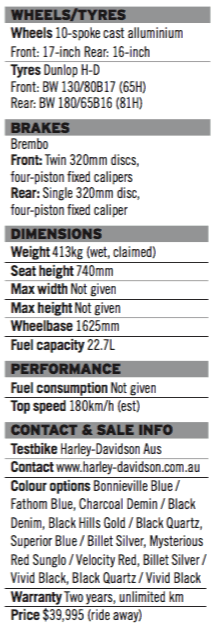The world of long-haul motorcycling is an ever-expanding genre that now covers adventure, adventure touring, sports touring… And then there’s the granddaddy of them all – touring. Proper touring, the sort that needs a mail redirection at your local post office and motorcycling’s equivalent of the Big Mac. When it comes to one with the lot, few are as well equipped as the big boy of Harley-Davidson’s touring range, the Ultra Limited. This is one big-ass machine designed to get you from point A, straight past points B and C and onto point D in style and comfort, and with a sense of elitism only experienced on a Harley.
For 2017 the Ultra Limited has received the new much-touted twin-cooled 107ci Milwaukee-Eight engine as well as a host of suspension upgrades designed to allow you to go stronger for longer. We took the big girl on a road trip to see if the new American mill can lug around more than half a tonne while dealing with Australian roads and weather conditions.
The biggest change for H-D’s 2017 touring range is the introduction of its new Milwaukee-Eight powerplant. The 107ci (1745cc) engine in air-cooled form has been fitted to the Road King, Road Glide and Street Glide touring models, however, the Ultra Limited has received the twin-cooled mill with liquid-cooled heads and slim radiators fitted to the lower leg fairings. It’s not the first time the Ultra Limited has had water added. In 2014 the launch of Project Rushmore saw the Ultra Limited powered by a twin-cooled version of the Twin Cam 103 engine.

As has become customary, H-D is not quoting power figures for the new Milwaukee-Eight engine, and it doesn’t need to. It’s always been about the torque with its big-bore, long-stroke V-twin engines. The new four-valve heads (two valves in the Twin Cam 103 engine) are fed by a 55mm throttle body with a redesigned intake and exhaust system. The result is a noticeably smoother and better breathing 45º engine with a claimed 12Nm increase in peak torque over the 1690cc Twin Cam 103 engine (138Nm to 150Nm) at just 3250rpm. Adding the twin cooling to the Ultra Limited adds 2Nm (up to 152Nm) at the same revs.
Also new is an upgraded suspension package for the unchanged touring frame. Externally, the Showa fork looks the same as the 49mm unit fitted to the 2016 model, but internally there’s new dual-bending valve technology for improved damping.
Further suspension upgrades can be found at the rear, with large-piston emulsion-style shocks replacing the rather tricky preload units that required a manual hand-pump to adjust. There has been the odd horror story about owners using a service station pump on their rear shocks only to accidentally blow the seals. The change to hydraulic shocks has also increased the preload range and ease of use, something I discovered when it came time to play with the rear suspension setting on
the run.

The Ultra Limited is instantly recognisable by its sheer size, which is enhanced by the large topbox that doubles as a pillion back rest – it’s like a lounge chair with speakers built into the arms. And if you think the bike looks big as you approach it, wait until you climb aboard. Those intimidated by large motorcycles will probably think twice about jumping on the Ultra Limited, but in practice it’s not much different to any other large capacity bike. The low 740mm seat height will allow most riders to plant two feet firmly on the ground with leg extension to spare. Some care still needs to be taken in tight spaces as this is a 400kg-plus motorcycle and just short of 2.5 meters long. Sitting on it and moving feels easier than trying to push it around.
Flicking the starter switch brings the Milwaukee-Eight to life with ease. While most manufacturers strive for smoothness, the pop and rattle of the big American V-twin at ignition is part of the experience Harley riders expect and demand. And while the new powerplant is noticeably smoother at start-up and idle (a claimed 25 percent smoother), the note from the stock exhaust is unmistakably meatier than the Twin Cam 103B engine. A little less rattle and hum and more rock ’n’ roll.
Something that is conspicuous by its absence is the clunk when first gear is engaged. A new hydraulic torque-assist clutch provides a lighter feel and has all but eliminated the clunk as well as removing some of the agricultural feel from the six-speed gearbox. While that loud drop from neutral into first gear is often criticised, I felt something was missing, and often found myself kicking the heel-and-toe shifter while waiting at the lights to make sure first gear had been selected. The slip-assist clutch and the low-down torque of the engine make pulling away child’s play.

The Ultra Limited may be designed for touring duties, but one of the most impressive things about this highway heavyweight is its low-speed stability. You sit in the bike rather than on it, and the low centre of gravity provided by the rider’s body weight and the big V-twin engine makes negotiating the urban jungle a lot simpler than you’d expect. The look of horror on drivers’ faces as you effortlessly lane filter through the tightest of gaps is priceless.
Out on the freeway, reaching the 110km/h limit is simply a case of twisting the throttle in any gear and watching the needle on the analogue speedo rotate around the face of the dial at the same pace as the needle on the tacho. At just 3250rpm, the 1745cc donk is already producing its full complement of grunt. The Milwaukee-Eight likes to rev and will happily push on to the 5500rpm rev limiter, but that’s not as much fun as going up a gear and riding the fat wave of torque – all the real fun happens down low. At just 2500rpm in sixth gear, the bike is sitting on 110km/h with the engine under less stress than the rider, who by this time should have the tunes blasting from the five-speaker stereo.

The Ultra Limited may be designed as a highway hauler, but throwing a motorcycle at a twisting and turning ribbon of tarmac is always the best – and most fun – way to test it. The improvement in ride and handling offered by the new suspenders was instantly noticeable through the twisties. The bike now feels more connected with the road, especially at the front end. Maximum lean angle is just 32º, but you don’t need to scrape the footboards to coax it around a bend in the same fashion as the raked-out Breakout model. The 26º rake and 170mm trail work well on the big bike and it’s not until you really start to push along that you feel it beginning to lean on the front tyres a little too much.
You can’t force a big bike like the Ultra Limited into a corner. The best approach is to use its weight as an advantage and allow the bike to flop into a bend with a touch of counter steering. While it’s by no means quick steering, it has little trouble changing direction and can be punted along at an exciting pace once you feel comfortable on the bike.
Initially, the bumps and undulations of our typical Aussie country roads seemed to be a little too much for the suspension at higher speeds – both ends struggled to keep pace when falling into dips and potholes. As the fork is non-adjustable, I went in search of a solution at the rear. Removal of the left-hand pannier proved far simpler than on the 2016 models thanks to redesigned fasteners, and once removed the preload knob is easy to access and use. A few turns on the knob from 5 to 10 on the numbered adjuster, and I was back on the road within five minutes – and enjoying a dramatically improved ride and more connected feel.

Braking is handled by four-piston Brembo calipers clamping twin 320mm discs up front, and a single 320mm disc and four-piston caliper at the rear. The system is linked and equipped with ABS, providing greater safety for less-skilled riders who tend to favour the rear brake. Even with just a single rider aboard, the stoppers are being asked to pull up almost half a tonne. Rear brakes alone will rarely achieve the task, especially in an emergency stop.
Pulling the big girl up in a hurry requires a decent application of front and rear brakes simultaneously, but the feedback is strong. Using the rear brake also helps pull the bike into corners in the absence of engine braking from the low-revving engine. Add a pillion and a full complement of luggage, and you need to get into the habit of using both levers all the time. To their credit, no matter how much I punished the brakes, they felt just as effective at the end of a ride as at the start. Exactly what you want from a braking package: consistency.

Riding on a day when the mercury was pushing 30º gave me a chance to test Harley’s claims of decreased “thermal intrusion”. As well as a lower idle speed that results in the engine running cooler (see breakout) a new exhaust system has been designed to disperse the heat away from the rider with the catalytic converter relocated just behind the front footboards. The changes have improved rider comfort; however, a big V-twin is always going to produce a substantial amount of heat on a hot day, and the rising temperature became noticeable when stuck in traffic. On the flip side, there does seem to be a significant improvement in comfort over the 2016 model. I felt a hot spot in the exhaust system on my right heel, but once moving it didn’t take long for the heat to dissipate thanks to the numerous air vents fitted to the Ultra Limited’s fairing. These can be closed if the weather turns nasty, keeping you warm and mostly dry.
The stubby screen on the batwing fairing is another Project Rushmore triumph. It doesn’t block the view ahead but offers enough wind deflection to eliminate wind buffeting at all speeds. You still get a healthy dose of fresh air smashing you in the face, but without the annoying air turbulence.

Harley-Davidson no longer has a monopoly on big tourers. They now come in metric and imperial sizes with Honda, Victory and Indian all offering their own interpretations of a two-wheeled Winnebago. For $39,995 ride away the Ultra Limited sits below the Indian Roadmaster ($40,995 ride away) and above Honda ‘s Goldwing ($35,999 + ORC). While the Ultra Limited is $1000 less expensive than the Indian Roadmaster, it does lack heated grips and heated seats as standard.
Motorcycle behemoths may not be everyone’s dream bike, but there is no denying they attract plenty of attention wherever you park them. Just make sure that it’s not on a hill nose down to the gutter – they are a bastard to push backward!

PHOTOGRAPHY AYY LMAO













